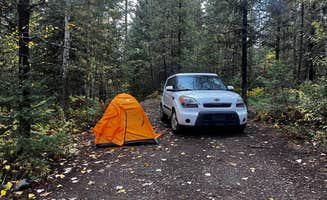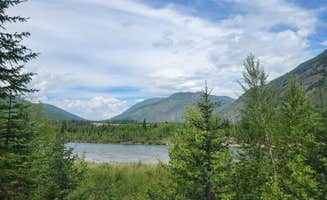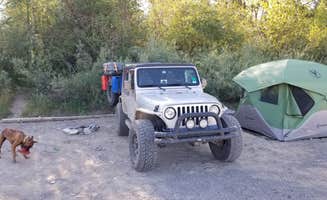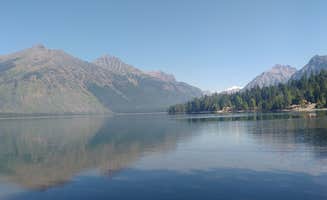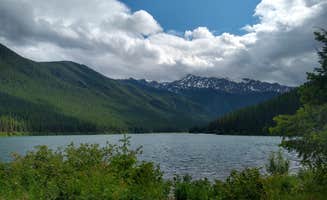Dispersed camping areas around Glacier National Park offer primitive overnight options for visitors seeking alternatives to developed campgrounds. Most sites sit on Flathead National Forest land within a 30-minute drive of West Glacier, providing basic accommodations with no running water. Access varies seasonally, with high water affecting river sites in spring and early summer. Logging operations periodically close some forest roads.
What to do
Float the river: The Flathead River provides excellent rafting opportunities near camping areas. At Middle Fork Flathead River, "rafters go by" regularly from nearby put-in points. According to a visitor at Middle Fork Flathead River Dispersed, the area serves as "a local entry and exit for guides, fishers, floaters, and swimmers."
Swimming: Cold river plunges provide relief during summer heat. A camper at Blankenship Bridge - Dispersed Camping notes you can "sit in the river and relax," while another mentions the river was "great to swim in for a little cold plunge."
Stargazing: The minimal light pollution around dispersed sites creates exceptional night sky viewing. One camper at North Fork Flathead River describes how "the stars are so bright and the Milky Way seems so close you could touch it." Another recommends primitive camping spots where you can "sit by the fire, relax and enjoy the beautiful night sky above you!!!"
Wildlife viewing: The forest setting offers opportunities to spot local wildlife. One camper reported seeing "a bald eagle" while staying near the river. Others mention encounters with wild horses in the meadows near East Glacier.
What campers like
Privacy at less-visited sites: Some dispersed camping areas offer more seclusion than others. At Glacier Rim River Access 10363, a camper notes it's "much more private than Middle Fork, only 3 spots and you can only stay for 3 days," while another describes it as "tucked away between the road and the river. It's super peaceful."
Cell service in select spots: Coverage varies widely across the dispersed camping areas. At Middle Fork Flathead River, one reviewer mentions, "Good cell service with AT&T." Another camper at McGinnis Creek reports, "Verizon and tmobile service but only 1 to 2 bars."
Natural surroundings: Campers appreciate the primitive setting with minimal development. One visitor described their site as "Thick, secluded, amazing... The river was 15' away and guided me and the wife to sleep." Another commented on the "massive lot right on the river" at Middle Fork.
Multiple camping options: Different areas accommodate various camping styles. At Blankenship Bridge, a reviewer notes there are "plentiful sites, some with fire rings, though many spots for car or van campers to park near the beautiful river." At another site, a camper observed "There are about 5 spots for bigger trailers."
What you should know
Road conditions vary significantly: Forest access roads range from good gravel to deeply rutted. At Blankenship Bridge, a camper warns, "Deep rutted muddy holes filled with water to get to site. Sketchy low trees and narrow road." Similarly, at Middle Fork Flathead River, visitors report "The road to the beach is quite rough" and "Road has huge and I mean huge puddles."
Stay limits differ by location: Each dispersed camping area has specific duration restrictions. At Glacier Rim River Access, reviewers note "Maximum stay is 3 days," while McGinnis Creek and other Forest Service sites typically allow up to 16 days.
Seasonal closures and restrictions: Sites may close unexpectedly. At Ryan Road Dispersed Camping, multiple recent visitors reported "Closed for Logging" with "signage that said temporarily closed to public access due to logging work." Another site reported being "Closed for high water."
Crowds during peak season: The free sites fill quickly in summer, particularly those closest to park entrances. One visitor observed North Fork gets "pretty crowded" with "the best spots for rvs were taken up by tents." At Middle Fork, a camper noted, "Be prepared for lots of traffic."
Tips for camping with families
Choose river sites with beaches: Sandy shorelines provide natural play areas. At North fork Flathead River dispersed camping, visitors mention "There is a a vaulted toilet. No other amenities. There is a trail by the woods that leads to water but you can also go directly to the water by the launch."
Consider vault toilet availability: Some primitive sites have basic facilities. One camper notes, "Pit toilet on the other side of the bridge" at Middle Fork, while another mentions "There are porta potties dispersed throughout" at the same location.
Watch for safety hazards: Monitor river conditions and wildlife. One camper warns about "Strong currents" at North Fork Flathead River. Another notes, "Be aware of animals especially where we camped."
Pack insect repellent: Mosquitoes can be problematic in summer. One camper at Ryan Road Dispersed Camping observed "Mosquitos were pretty bad," while others recommend bringing "bug spray" for comfort.
Tips from RVers
Vehicle clearance matters: Road access varies greatly for larger vehicles. At Ryan Road Dispersed #2, a camper with a trailer reports, "Not much for turn around space, especially for a larger rig. If sites at end of road are packed you may be up a creek." Another visitor notes, "Some very big sites (2-3 could probably fit a larger 30'+ rig)."
Arrive early for best spots: Limited large vehicle spaces fill quickly. One RVer at Ryan Road observed, "We grabbed one. It could fit a 20-25' camper with vehicle at most," while another mentioned, "The place emptied out pretty well mid-week (peak season)."
Check site access before committing: Forest roads may have unexpected challenges. A visitor to McGinnis Creek advises, "We managed to find a spot on a side road before the gates, that fit our 32' travel trailer." At Blankenship Bridge, an RVer with a larger trailer warns they "Had to do a walk around after to verify no damage" after navigating the difficult access road.
Water access planning: No drinking water is available at dispersed sites. One RVer notes the "spigot that used to be available outside the park gates are no longer available. Closest water is inside the park at the picnic areas."


